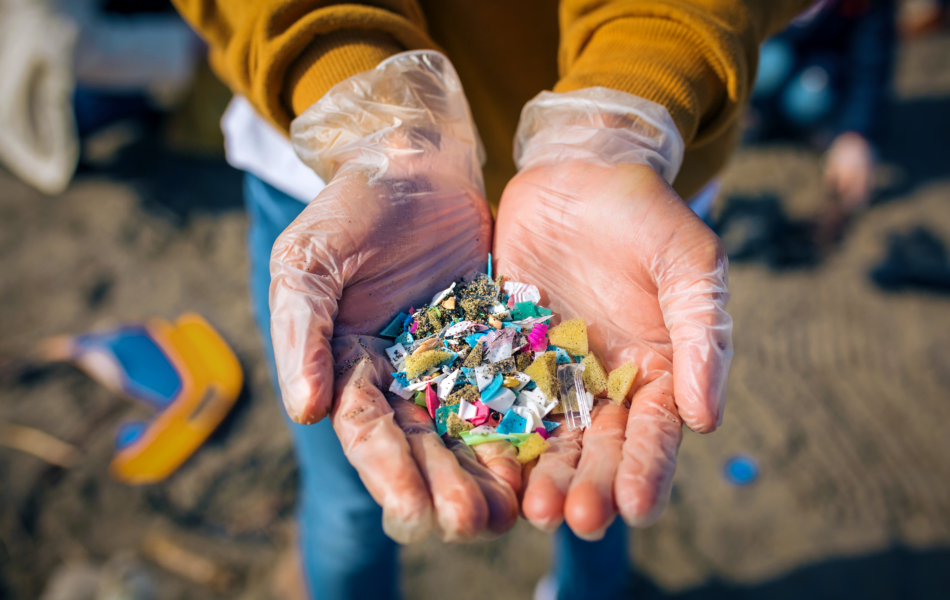By Stella Tsianta,
Did you know that you might be ingesting around the mass of a credit card’s worth of microplastic a year?
Plastic is an essential element in our century. Almost 400 million tons of plastics are produced each year, a mass projected to be more than doubled by 2050. Most of it ends up in the ocean and breaks up into very small particles, called “microplastics”. These tiny plastic particles are officially defined as plastics less than five millimeters (0.2 inches) large. There are two categories of microplastics: primary and secondary.
Primary microplastics are tiny particles, intentionally designed to be small. Microfibers shed from clothing and other textiles, such as fishing nets, are called “microbeads”. These are used in many health and beauty products (they’re usually added as exfoliants in beauty products; they’re even added in toothpaste), as well as microfibers shed from clothing and other textiles. Secondary microplastics are particles that form when bigger plastic products, such as water bottles, are broken down. Exposure to external stimuli, namely the sun’s rays and ocean waves, causes this disintegration. The largest source of secondary plastics in the environment is single-use plastics, which are plastic products that are intended to be used once and then discarded, such as straws. Microplastics can be seen as minute colorful plastic pieces in the sand, on beaches. In the oceans, microplastic pollution is often consumed by marine animals.
Microbeads are not a problem that has occurred recently. According to the United Nations Environment Program, plastic microbeads first appeared in personal care products, about 50 years ago, as plastics were increasingly replacing natural ingredients. These tiny particles easily pass through water filtration systems and end up in the ocean and Great Lakes, posing a potential threat to aquatic life; in 2015, oceanographers estimated there were between 15 trillion and 51 trillion microplastic particles floating in surface waters worldwide. Not only that, but other particles from microplastics are found inland, so people might be inhaling or eating plastic from any source. Children and adults may consume anything from hundreds to more than 100,000 microplastic specks every day, according to limited assessments of microplastics in the air, water, salt, and seafood. In 2015, U.S. President Obama banned the use of microbeads in cosmetics and personal care products, in an effort of reducing microplastics found in the environment. More and more countries are joining this effort. Microplastics and the need for laws were mentioned in a United Nations resolution from 2017.

Are those plastic specks harmful? To begin with, if they are tiny enough to reach cells or tissues, they may irritate, simply, by being present — as long, thin asbestos fibers may inflame lung tissue and cause cancer. Chemical toxicity is more likely to have detrimental consequences in bigger microplastics, if any. Manufacturers add compounds, like plasticizers, stabilizers, and pigments to plastics, and many of these substances are hazardous — for example, when interfering with endocrine (hormonal) systems. Another idea is that microplastics might attract chemical pollutants in the environment and then deliver them to animals that consume the contaminated specks. But animals ingest pollutants from food and water anyway. The issue with microplastics is that, like other plastics, they take a long time to degrade into harmless molecules. Microplastics have been found in marine creatures, ranging from plankton to whales, as well as commercial seafood and drinking water. Standard water treatment systems, alarmingly, are unable to eliminate all evidence of microplastics. Microplastics in the water can bond with other toxic compounds, before being swallowed by marine creatures, thus further complicating the situation.
Jennifer Lynch, the lead researcher at Hawaii Pacific University’s Center for Marine Debris Research in Honolulu, has autopsied sea turtles, discovered dead on beaches, looking for plastics in their stomachs and toxins in their tissues. Her team produced a series of studies for 9 hawksbill turtle hatchlings, under the age of three weeks, in 2020. One hatchling, only 9 centimeters long, was found to have 42 pieces of plastic in its gastrointestinal tract. Most were microplastics.
One thing is clear: the problem will only grow bigger. Even if all plastic production was, magically, stopped tomorrow, existing plastics in landfills and the environment — a mass estimated at around 5 billion tons — would continue degrading into tiny fragments that are impossible to collect or clean up, constantly raising microplastic levels, creating a “plastic time bomb”.
You can help keep plastic out of the ocean. Just remember to Reduce, Reuse and Recycle.
References
- What are microplastics?, oceanservice.noaa.gov, Available here
- Microplastics are everywhere — but are they harmful?, nature.com, Available here




